2017高考英语阅读理解推理判断题命题方式与技巧点拨(附带答案)
- 格式:doc
- 大小:126.00 KB
- 文档页数:17
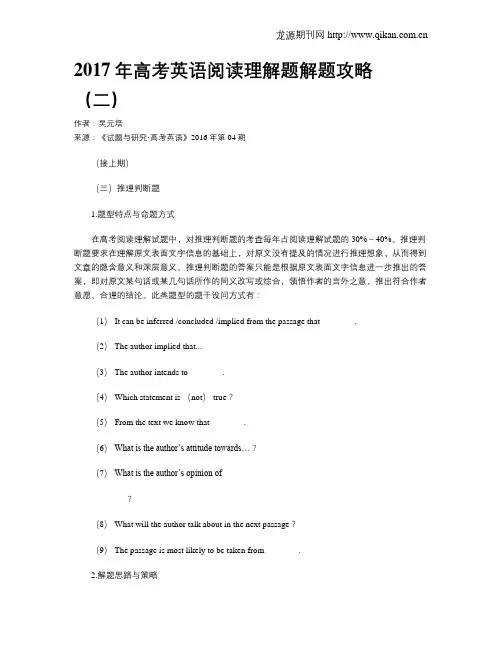
2017年高考英语阅读理解题解题攻略(二)作者:吴元培来源:《试题与研究·高考英语》2016年第04期(接上期)(三)推理判断题1.题型特点与命题方式在高考阅读理解试题中,对推理判断题的考查每年占阅读理解试题的30%~40%。
推理判断题要求在理解原文表面文字信息的基础上,对原文没有提及的情况进行推理想象,从而得到文章的隐含意义和深层意义。
推理判断题的答案只能是根据原文表面文字信息进一步推出的答案,即对原文某句话或某几句话所作的同义改写或综合,领悟作者的言外之意,推出符合作者意愿、合理的结论。
此类题型的题干设问方式有:(1) It can be inferred /concluded /implied from the passage that________.(2) The author implied that...(3) The author intends to________.(4) Which statement is (not) true?(5) From the text we know that________.(6)What is the author’s attitude towards…?(7)What is the author’s opinion of________?(8) What will the author talk about in the next passage?(9) The passage is most likely to be taken from________.2.解题思路与策略考生做题时一定要从整体上把握语篇内容,在语篇的表面意义与隐含意义、已知信息与未知信息间架起桥梁,透过字里行间,去体会作者的“弦外之音”。
(1)考生在阅读时,要抓住文章的主题和细节,分析文章结构,根据上下文内在联系,挖掘文章的深层含义。
在进行推理时,考生一定要仔细阅读短文,看透文章的表面意思,从字里行间捕捉有用的提示和线索。
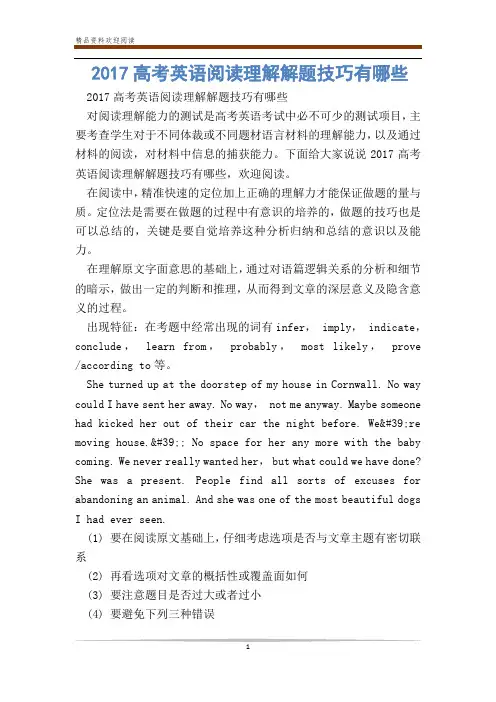
2017高考英语阅读理解解题技巧有哪些 2017高考英语阅读理解解题技巧有哪些对阅读理解能力的测试是高考英语考试中必不可少的测试项目,主要考查学生对于不同体裁或不同题材语言材料的理解能力,以及通过材料的阅读,对材料中信息的捕获能力。
下面给大家说说2017高考英语阅读理解解题技巧有哪些,欢迎阅读。
在阅读中,精准快速的定位加上正确的理解力才能保证做题的量与质。
定位法是需要在做题的过程中有意识的培养的,做题的技巧也是可以总结的,关键是要自觉培养这种分析归纳和总结的意识以及能力。
在理解原文字面意思的基础上,通过对语篇逻辑关系的分析和细节的暗示,做出一定的判断和推理,从而得到文章的深层意义及隐含意义的过程。
出现特征:在考题中经常出现的词有infer, imply, indicate,conclude,learn from,probably,most likely,prove /according to等。
She turned up at the doorstep of my house in Cornwall. No way could I have sent her away. No way, not me anyway. Maybe someone had kicked her out of their car the night before. We're moving house.'; No space for her any more with the baby coming. We never really wanted her, but what could we have done? She was a present. People find all sorts of excuses for abandoning an animal. And she was one of the most beautiful dogsI had ever seen.(1) 要在阅读原文基础上,仔细考虑选项是否与文章主题有密切联系(2) 再看选项对文章的概括性或覆盖面如何(3) 要注意题目是否过大或者过小(4) 要避免下列三种错误概括不够(多表现为部分代整体,导致范围过小),过度概括(多表现为扩大范围),以事实、细节代替抽象概括的大意。
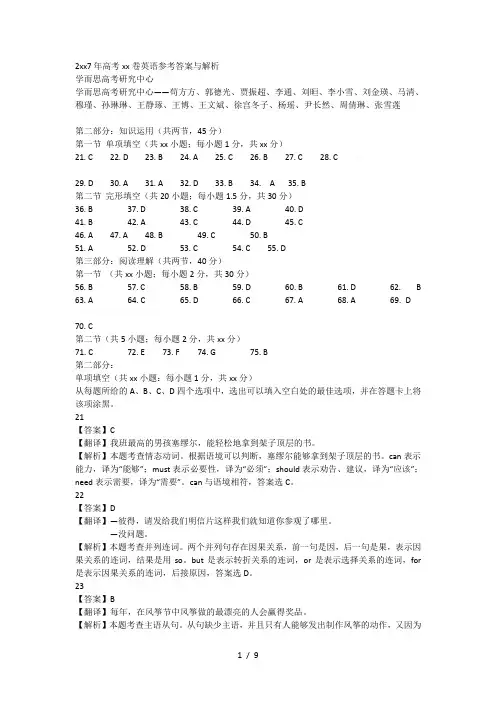
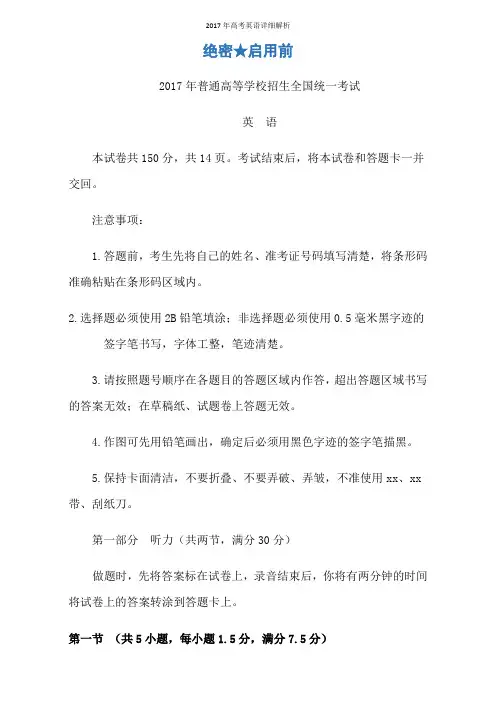
绝密★启用前2017年普通高等学校招生全国统一考试英语本试卷共150分,共14页。
考试结束后,将本试卷和答题卡一并交回。
注意事项:1.答题前,考生先将自己的姓名、准考证号码填写清楚,将条形码准确粘贴在条形码区域内。
2.选择题必须使用2B铅笔填涂;非选择题必须使用0.5毫米黑字迹的签字笔书写,字体工整,笔迹清楚。
3.请按照题号顺序在各题目的答题区域内作答,超出答题区域书写的答案无效;在草稿纸、试题卷上答题无效。
4.作图可先用铅笔画出,确定后必须用黑色字迹的签字笔描黑。
5.保持卡面清洁,不要折叠、不要弄破、弄皱,不准使用xx、xx 带、刮纸刀。
第一部分听力(共两节,满分30分)做题时,先将答案标在试卷上,录音结束后,你将有两分钟的时间将试卷上的答案转涂到答题卡上。
第一节(共5小题,每小题1.5分,满分7.5分)听下面5xx对话,每xx对话后有一个小题,从题中所给的A、B、C三个选项中选出最佳答案,听完每xx对话后,你都有10秒钟的时间来回答有关小题和阅读下一小题。
每xx对话尽读一遍。
例:How much is the shirt?答案是C。
1What will the woman do this afternoon?A .Do some exercise.B. Go shopping.C. Wash her clothes.2Why does the woman call the man?A. To cancel a flight.B. To make an apologyC. To put off a meeting.3 How much more does David need for the car?A. $ 5,000.B.$20,000.C. $25,000.4 What is Jane doing?A. Planning a tour.B.Calling her fatherCAsking for leave.5 How does the man feel?A. Tied.B. Dizzy.C. Thirsty.第二节(共15小题;每小题1.5分,满分22.5分)听下面5xx对话或独白。
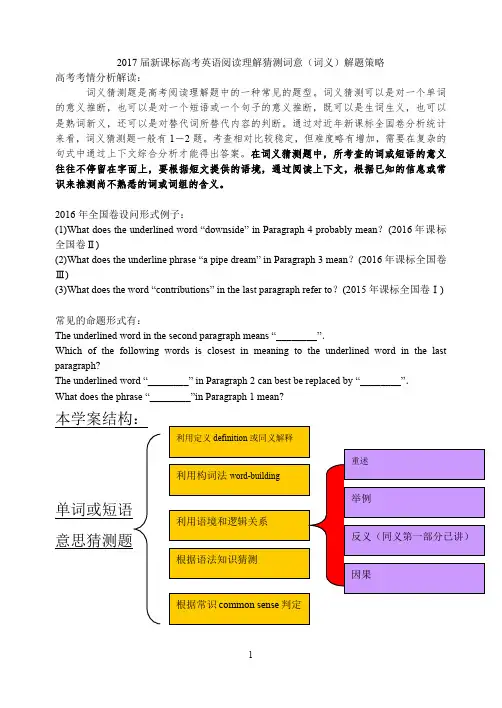
2017届新课标高考英语阅读理解猜测词意(词义)解题策略高考考情分析解读:词义猜测题是高考阅读理解题中的一种常见的题型。
词义猜测可以是对一个单词的意义推断,也可以是对一个短语或一个句子的意义推断,既可以是生词生义,也可以是熟词新义,还可以是对替代词所替代内容的判断。
通过对近年新课标全国卷分析统计来看,词义猜测题一般有1-2题。
考查相对比较稳定,但难度略有增加,需要在复杂的句式中通过上下文综合分析才能得出答案。
在词义猜测题中,所考查的词或短语的意义往往不停留在字面上,要根据短文提供的语境,通过阅读上下文,根据已知的信息或常识来推测尚不熟悉的词或词组的含义。
2016年全国卷设问形式例子:(1)What does the underlined word “downside” in Paragraph 4 probably mean?(2016年课标全国卷Ⅱ)(2)What does the underline phrase “a pipe dream” in Paragraph 3 mean?(2016年课标全国卷Ⅲ)(3)What does the word “contributions” in the last paragraph refer to?(2015年课标全国卷Ⅰ)常见的命题形式有:The underlined word in the second paragraph means “________”.Which of the following words is closest in meaning to the underlined word in the last paragraph?The underlined word “________” in Paragraph 2 can best be replaced by “________”.What does the phrase “________”in Paragraph 1 mean?本学案结构:意思猜测题代词指代猜测题目句子猜测句意题目附:典故谚语知识储备单词或短语意思猜测题该题型着重考查考生根据上下文猜测词义的能力,这也是一个从“已知”得出“未知”的过程,即利用上下文的已知部分(尤其是该词或短语前后的句子)进行推理,有时还需要依靠常识和经验来猜测词义。
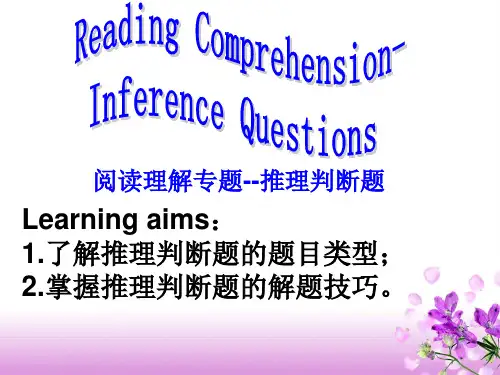
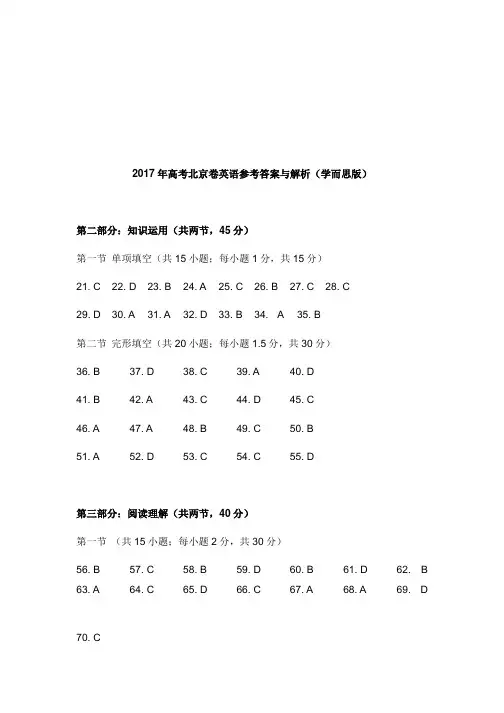
2017 年高考北京卷英语参考答案与解析(学而思版)第二部分:知识运用(共两节,45 分) 第一节 单项填空(共 15 小题;每小题 1 分,共 15 分) 21. C 29. D 22. D 30. A 23. B 31. A 24. A 32. D 25. C 33. B 26. B 34. A 27. C 35. B 28. C矚慫润厲钐瘗睞枥。
第二节 完形填空(共 20 小题;每小题 1.5 分,共 30 分) 36. B 41. B 46. A 51. A 37. D 42. A 47. A 52. D 38. C 43. C 48. B 53. C 39. A 44. D 49. C 54. C 40. D 45. C 50. B 55. D第三部分:阅读理解(共两节,40 分) 第一节 (共 15 小题;每小题 2 分,共 30 分) 56. B 63. A 57. C 64. C 58. B 65. D 59. D 66. C 60. B 67. A 61. D 68. A 62. B69. D聞創沟燴鐺險爱氇。
70. C第二节(共 5 小题;每小题 2 分,共 10 分) 71. C 72. E 73. F 74. G 75. B第二部分: 第一节 单项填空(共 15 小题:每小题 1 分,共 15 分) 从每题所给的 A、B、C、D 四个选项中,选出可以填入空白处的最佳选项, 并在答题卡上将该项涂黑。
21 【答案】C 【翻译】我班最高的男孩塞缪尔,能轻松地拿到架子顶层的书。
【解析】 本题考查情态动词。
根据语境可以判断, 塞缪尔能够拿到架子顶层的书。
can 表示能力,译为“能够”;must 表示必要性,译为“必须”;should 表示劝告、 建议,译为“应该”;need 表示需要,译为“需要”。
can 与语境相符,答案选 C。
残骛楼諍锩瀨濟溆。
22 【答案】D 【翻译】—彼得,请发给我们明信片这样我们就知道你参观了哪里。
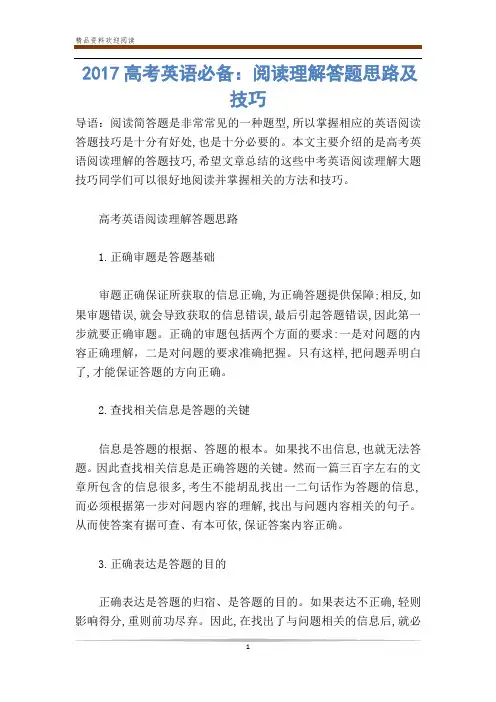
2017高考英语必备:阅读理解答题思路及技巧导语:阅读简答题是非常常见的一种题型,所以掌握相应的英语阅读答题技巧是十分有好处,也是十分必要的。
本文主要介绍的是高考英语阅读理解的答题技巧,希望文章总结的这些中考英语阅读理解大题技巧同学们可以很好地阅读并掌握相关的方法和技巧。
高考英语阅读理解答题思路1.正确审题是答题基础审题正确保证所获取的信息正确,为正确答题提供保障;相反,如果审题错误,就会导致获取的信息错误,最后引起答题错误,因此第一步就要正确审题。
正确的审题包括两个方面的要求:一是对问题的内容正确理解,二是对问题的要求准确把握。
只有这样,把问题弄明白了,才能保证答题的方向正确。
2.查找相关信息是答题的关键信息是答题的根据、答题的根本。
如果找不出信息,也就无法答题。
因此查找相关信息是正确答题的关键。
然而一篇三百字左右的文章所包含的信息很多,考生不能胡乱找出一二句话作为答题的信息,而必须根据第一步对问题内容的理解,找出与问题内容相关的句子。
从而使答案有据可查、有本可依,保证答案内容正确。
3.正确表达是答题的目的正确表达是答题的归宿、是答题的目的。
如果表达不正确,轻则影响得分,重则前功尽弃。
因此,在找出了与问题相关的信息后,就必须结合问题的要求,对信息进行加工、整合、处理,保证答案的形式正确,从而使答案正确无误。
高考英语阅读理解答题技巧考试时间短,任务重,怎样才能使考试作答又快又准呢?考生应该掌握一下答题技巧。
1.先题后文,有的放矢考生在答题之前,先浏览一下问题,弄清问题的内容和要求。
然后带着问题去阅读文章,从而避免了文章中无关信息的干扰,使阅读有意识、有目的地进行。
2.快速阅读,找出信息阅读文章时,对于与问题无关的信息一扫而过,特别是对与问题无关的生词,当放下的就必须放下,切不可纠缠不清,耽误时间;而对于与问题相关的信息在阅读时就一边用笔将其圈划出来。
待到把文章阅读完以后,只要对这些信息进行处理即可。
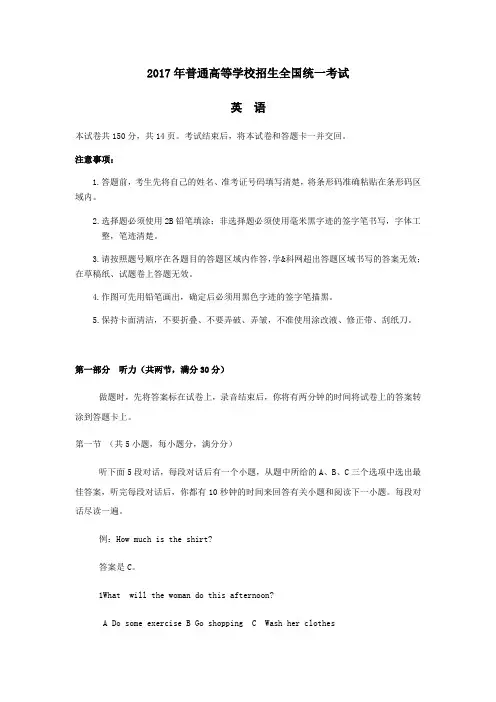
2017年普通高等学校招生全国统一考试英语本试卷共150分,共14页。
考试结束后,将本试卷和答题卡一并交回。
注意事项:1.答题前,考生先将自己的姓名、准考证号码填写清楚,将条形码准确粘贴在条形码区域内。
2.选择题必须使用2B铅笔填涂;非选择题必须使用毫米黑字迹的签字笔书写,字体工整,笔迹清楚。
3.请按照题号顺序在各题目的答题区域内作答,学&科网超出答题区域书写的答案无效;在草稿纸、试题卷上答题无效。
4.作图可先用铅笔画出,确定后必须用黑色字迹的签字笔描黑。
5.保持卡面清洁,不要折叠、不要弄破、弄皱,不准使用涂改液、修正带、刮纸刀。
第一部分听力(共两节,满分30分)做题时,先将答案标在试卷上,录音结束后,你将有两分钟的时间将试卷上的答案转涂到答题卡上。
第一节(共5小题,每小题分,满分分)听下面5段对话,每段对话后有一个小题,从题中所给的A、B、C三个选项中选出最佳答案,听完每段对话后,你都有10秒钟的时间来回答有关小题和阅读下一小题。
每段对话尽读一遍。
例:How much is the shirt?答案是C。
1What will the woman do this afternoon?A Do some exerciseB Go shoppingC Wash her clothes2Why does the woman call the man?A To cancel a flightB To make an apologyC To put off a meeting3 How much more does David need for the car?A $ 5,000 B$20,000 C $25,0004 What is Jane doing?A Planning a tour BCalling her father CAsking for leave5 How does the man feel?A TiedB DizzyC Thirsty第二节(共15小题;每小题分,满分分)听下面5段对话或独白。
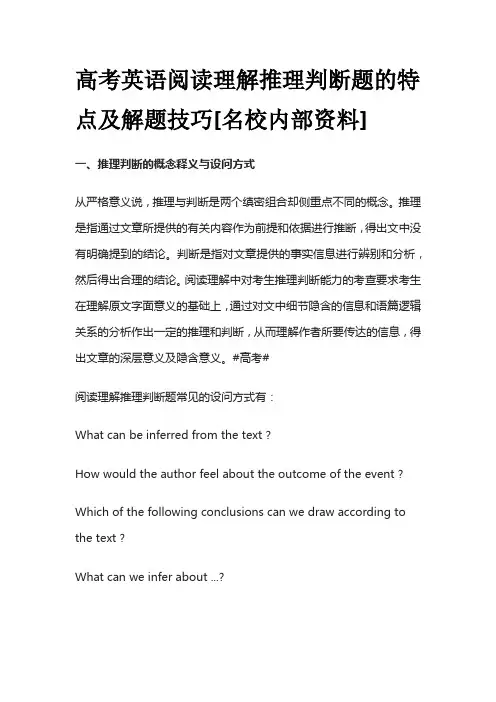
高考英语阅读理解推理判断题的特点及解题技巧[名校内部资料]一、推理判断的概念释义与设问方式从严格意义说,推理与判断是两个缜密组合却侧重点不同的概念。
推理是指通过文章所提供的有关内容作为前提和依据进行推断,得出文中没有明确提到的结论。
判断是指对文章提供的事实信息进行辨别和分析,然后得出合理的结论。
阅读理解中对考生推理判断能力的考查要求考生在理解原文字面意义的基础上,通过对文中细节隐含的信息和语篇逻辑关系的分析作出一定的推理和判断,从而理解作者所要传达的信息,得出文章的深层意义及隐含意义。
#高考#阅读理解推理判断题常见的设问方式有:What can be inferred from the text ?How would the author feel about the outcome of the event ?Which of the following conclusions can we draw according to the text ?What can we infer about ...?What can we know about the ... from the first paragraph ? What can we infer from the last paragraph ?What is the purpose of the last part of the text ?What is the author's purpose in writing the text ?What is the author's attitude to / toward the ...?Where might this passage be taken from ?What does the text imply ?Where can the text be found ?Where is the passage most likely to be taken from ?Where would this passage most probably appear ?二、推理判断题的细分题型特点及其解题技巧高考英语阅读理解推理判断题,根据考查的深层次内容,又可以再细分为“隐含意义推断题,观点态度推断题,写作意图推断题,文章出处或写作类型推断题和篇章结构推断题”5种小类型。
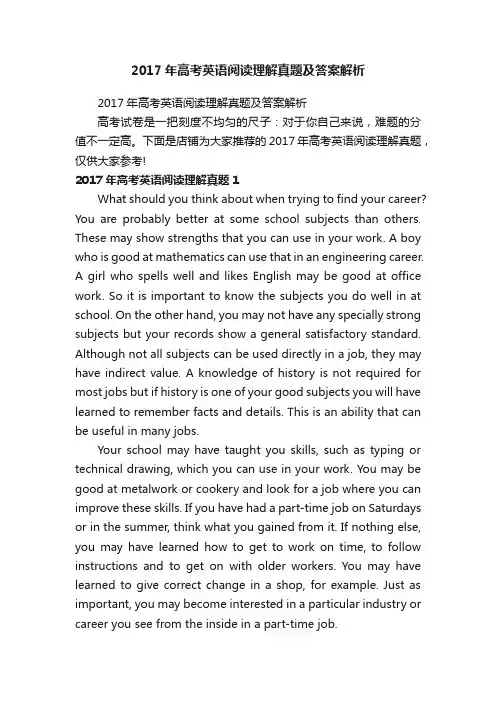
2017年高考英语阅读理解真题及答案解析2017年高考英语阅读理解真题及答案解析高考试卷是一把刻度不均匀的尺子:对于你自己来说,难题的分值不一定高。
下面是店铺为大家推荐的2017年高考英语阅读理解真题,仅供大家参考!2017年高考英语阅读理解真题1What should you think about when trying to find your career? You are probably better at some school subjects than others. These may show strengths that you can use in your work. A boy who is good at mathematics can use that in an engineering career.A girl who spells well and likes English may be good at office work. So it is important to know the subjects you do well in at school. On the other hand, you may not have any specially strong subjects but your records show a general satisfactory standard. Although not all subjects can be used directly in a job, they may have indirect value. A knowledge of history is not required for most jobs but if history is one of your good subjects you will have learned to remember facts and details. This is an ability that can be useful in many jobs.Your school may have taught you skills, such as typing or technical drawing, which you can use in your work. You may be good at metalwork or cookery and look for a job where you can improve these skills. If you have had a part-time job on Saturdays or in the summer, think what you gained from it. If nothing else, you may have learned how to get to work on time, to follow instructions and to get on with older workers. You may have learned to give correct change in a shop, for example. Just as important, you may become interested in a particular industry or career you see from the inside in a part-time job.Facing your weak points is also part of knowing yourself. You may be all thumbs when you handle tools; perhaps you are a poor speller or cannot add up a column of figures. It is better to face any weakness than to pretend they do not exist. Your school record, for instance, may not be too good, yet it is an important part of your background. You should not be apologetic about it but instead recognize that you will have a chance of a fresh start at work.46. We can infer from the first paragraph that ________.learning better at school shows power in your jobthe better you are at school subjects, the more helpful they are in your career.learning each subject well is an ability in many jobs.we should think about how to find our career47. From the passage we learn that if a student’s school performance is not good, he will _____.A. have no hope in his future workB. be hopeful to find a suitable jobC. regret not having worked harder at schoolD. have an opportunity of a new beginning in his future work48. All the subjects may have direct value for job hunting except _________.A. mathematicsB. EnglishC. historyD. technical drawing49. The underlined phrase “be all thumbs” (in Paragraph 3) probably means “_________”.A. heavy- handedB. the bestC. importantD. skilled50. The passage mainly discusses ___________.A. The relationship between school performance and careerB. how to get a jobC. How to show strengths in your workD. working experience and knowledge at school答案:46- 50 BDCAA2017年高考英语阅读理解真题2In modern society there is a great deal of argument about competition. Some value it highly, believing that it is responsible for social progress and prosperity, others say that competition is bad; that it sets one person against another; that it leads to unfriendly relationship between people.I have taught many children who held the belief that their self – worth relied (依赖) on how well they performed at tennis and other skills. For them, playing well and winning are often life – and – death affairs. In their single – minded pursuit (追求) of success, the development of many other human qualities is sadly forgotten.However, while some seem to be lost in the desire to succeed, others take an opposite attitude. In a culture which values only the winner and pays no attention to the ordinary players, they strongly blame competition. Among the most vocal are youngsters who have suffered under competitive pressures from their parents or society. Teaching these young people, I often observe in them a desire to fail. They seem to se ek failure by not trying to win or achieve success. By not trying, they always have an excuse: “I may have lost, but it doesn’t matter because I really didn’t try.” What is not usually admitted by themselves is the belief that if they had really tried and lost, that would mean a lot. Such a loss would be a measure of their worth. Clearly, this belief is the same as that of the true competitors who try to prove t hemselves. Both are based on the mistaken belief that one’s self – respect relies on how well one performs in comparison with others. Both are afraid of not being valued. Only as this basic andoften troublesome fear begins to dissolve (缓解) can we discovera new meaning in competition.41.What does this passage mainly talk about?petition helps to set up self – respect.B.Opinions about competition are different among people.petition is harmful to personal quality development.D.Failures are necessary experiences in competition42.Why do some people favor competition according to the passage?A.It pushes society forward.B.It builds up a sense of duty.C.It improves personal abilities.D.It encourages individual efforts.43.The underlined phrase “the most vocal” in Paragraph 3 means .A.those who try their best to winB.those who value competition most highlyC.those who are against competition most stronglyD.those who rely on others most for success44.What is the similar belief of the true competitors and those with a desire to fail ?A.One’s worth lies in his performance compared with others.B.One’s success in competition needs great efforts.C.One’s achievement is determined by his particular skills.D.One’s success is based on how hard h e has tried.45.Which point of view may the author agree to?A.Every effort should be paid back.petition should be encouraged.C.Winning should be a life – and – death matter.D.Fear of failure should be removed in competition.答案:41.B 42.A 43.C 44.A 45.D2017年高考英语阅读理解真题3Sometimes you’ll hear people say that you can’t love others until you love yourself.Sometimes you’ll hear people say that you can’t expect someone else to love you until you love yourself.Either way, you’ve got to love yourself first and this can be tricky.Sure we all know that we’re the apple of our parents’ eyes, and that our Grandmas think we’re great talents and our Uncle Roberts think that we will go to the Olympics.but sometimes it’s a lot harder to think such nice thoughts abou t ourselves.If you find that believing in yourself is a challenge.it is time you build a positive self-image and learn to love yourself.Self-image is your own mind’s picture of yourself.This image includes the way you look, the way you act, the way you talk and the way you think.Interestingly, our self-images are often quite different from the images others hold about US.Unfortunately, most of these images are more negative than they should be.Thus changing the way you think about yourself is the key to changing your self-image and your whole world.The best way to defeat a passive self-image is to step back and decide to stress your successes.That is, make a list if you need to, but write down all of the great things you do every day.Don’t allow doubts to occur in it.It very well might be that you are experiencing a negative self-image because you can’t move past one flaw or weakness that you see about yourself.Well, roll up your sleeves and make a change of it as your primary task.If you think you’re sill y because you aren’t good at math, find a tutor.If you think you’re weak because you can’t run a mile, get to the track and practice.If you think you’re dull because you don’t wear thelatest trends, buy a few new clothes.But remember, just because you thi nk it doesn’t mean it’s true.The best way to get rid of a negative serf-image is to realize that your image is far from objective, and to actively convince yourself of your positive qualities.Changing the way you think and working on those you need to improve will go a long way towards promoting a positive self-image.When you can pat(拍) yourself on the back, you’ll know you’re well on your way.Good luck!41.You need to build a positive self-image when you _________.A.dare to challenge yourselfB.feel it hard to change yourselfC.are unconfident about yourselfD.have a high opinion of yourself42.According to the passage, our serf-images _________.A.have positive effectsB.are probably untrueC.are often changeableD.have different functions43.How should you change your serf-image according to the passage?A.To keep a different image of others.B.To make your life successful.C.To understand your own world.D.To change the way you think.44.What is the passage mainly about?A.How to prepare for your success.B.How to face challenges in your life.C.How to build a positive self-image.D.How to develop your good qualities.45.Who are the intended readers of the passage?A.Parents.B.Adolescents.cators.D.People in general.答案:41—45CBDCB。
绝密★启用前本试卷分为第I卷〔选择题〕与第II卷〔非选择题〕两局部,共130分,考试用时100分钟。
第I卷1至10页,第II卷11至12页。
答卷前,考生务必将自己的姓名、准考号填写在答题卡上,并在规定位置粘贴考试用条形码。
答卷时,考生务必将答案涂写在答题卡上,答在试卷上的无效。
考试完毕后,将本试卷与答题卡一并交回。
祝各位考生考试顺利!第I卷考前须知:1. 每题选出答案后,用铅笔将答题卡上对应题目的答案标号涂黑。
如需改动,用橡皮擦干净后,再选涂其他答案标号。
2. 本卷共55小题,共95分。
第一局部:英语知识运用〔共两节,总分值45分〕第一节:单项填空〔共15小题;每题1分,总分值15分〕从A、B、C、D四个选项中,选出可以填入空白处的最正确选项。
例:Stand over there___________ you’ll be able to see it better.A. orB. andC. butD. while答案是B。
1. —Albert’s birthday is on next Saturday, and I’m planning a surprise party for him.—__________. I’ll bring some wine.A. Sounds like funB. It dependsC. Just a minuteD. You are welcome 【答案】A【解析】2. My room is a mess, but I __________clean it before I go out tonight. I can do it in the morning.A. daren’tB. shouldn’tC. needn’tD. mustn’t【答案】C【解析】试题分析:句意:我的房间很乱,但是在今晚我出去之前不需要清扫,我可以明天早晨再清扫。
A. 不敢;B. 不应该;C. 不需要;D. 制止。
2017年高考北京卷英语参考答案与解析学而思高考研究中心学而思高考研究中心——苟方方、郭德光、贾振超、李通、刘晅、李小雪、刘金瑛、马清、穆瑾、孙琳琳、王静琢、王博、王文斌、徐宫冬子、杨瑶、尹长然、周倩琳、张雪莲第二部分:知识运用(共两节,45分)第一节单项填空(共15小题;每小题1分,共15分)21. C 22. D 23. B 24. A 25. C 26. B 27. C 28. C29. D 30. A 31. A 32. D 33. B 34. A 35. B第二节完形填空(共20小题;每小题1.5分,共30分)36. B 37. D 38. C 39. A 40. D41. B 42. A 43. C 44. D 45. C46. A 47. A 48. B 49. C 50. B51. A 52. D 53. C 54. C 55. D第三部分:阅读理解(共两节,40分)第一节(共15小题;每小题2分,共30分)56. B 57. C 58. B 59. D 60. B 61. D 62. B 63. A 64. C 65. D 66. C 67. A 68. A 69. D 70. C第二节(共5小题;每小题2分,共10分)71. C 72. E 73. F 74. G 75. B第二部分:第一节单项填空(共15小题:每小题1分,共15分)从每题所给的A、B、C、D四个选项中,选出可以填入空白处的最佳选项,并在答题卡上将该项涂黑。
21【翻译】我班最高的男孩塞缪尔,能轻松地拿到架子顶层的书。
【解析】本题考查情态动词。
根据语境可以判断,塞缪尔能够拿到架子顶层的书。
can表示能力,译为“能够”;must表示必要性,译为“必须”;should表示劝告、建议,译为“应该”;need表示需要,译为“需要”。
can与语境相符,答案选C。
22【答案】D【翻译】—彼得,请发给我们明信片这样我们就知道你参观了哪里。
2017高考英语阅读理解推理判断题命题方式与技巧点拨(附带答案)-CAL-FENGHAI-(2020YEAR-YICAI)_JINGBIAN高三英语阅读理解推理判断题命题方式与技巧点拨讲课导入:高考英语阅读理解考纲关于阅读理解部分考纲要求:阅读部分要求考生能读懂书、报、杂志中关于一般性话题的简短文段以及公告、说明、广告等,并能从中获取相关信息。
考生应能:(1)理解主旨要义;(2)理解文中具体信息;(3)根据上下文推断单词和短语的含义;(4)做出判断和推理;(5)理解文章的基本结构;(6)理解作者的意图、观点和态度。
高考英语阅读理解常见的设题形式有:细节理解题、推理判断题、词意猜测题、主旨大意题。
本节主要解决推理判断题解题策略。
推理判断题解题指导:■考点突破一、命题方式:推理判断是指在理解原文字面意义的基础上,通过对语篇逻辑关系的分析和细节的暗示,做出一定的判断和推理,从而得出文章的深层意义及隐含意义的过程。
主要考查考生理清上下文逻辑关系的能力以及考生的识别能力。
推理题所涉及的内容可能是文中某一句话,也可能是某几句话,要求考生在遵循原文意义的基础上,对文章字面信息进行分析、挖掘、逻辑推理,揭示其深层含义。
推理判断题的命题区间往往出现在以下几个方面:◆文章或者段落的首尾部分。
这一部分往往会引出文章的主题,总结全文或者全段内容,通常也会设计推理判断题;◆引言部分。
议论文或者说明文中作者经常引用他人语言来支撑自己的观点,引用的内容可能从正面或者反面来支持作者的观点,引文的字里行间隐含的渗透的内容往往也是命题人设题的依据;◆结论建议处。
命题人往往在文章中出现the study suggests, the research indicates, the report shows 等类似结论、建议性表达方式时,此处通常是文章中提到的研究结果或者报告的结论,命题人往往在此设置推理判断题◆表达观点态度处。
在作者表达观点态度的地方往往设置推理判断题。
江苏2017高考英语阅读理解【推理判断题】讲解及选练(含答案)阅读理解解题指导阅读理解历来都是高考英语试卷中难度最大、区分度最高的题型,它要求考生理解文章的主旨和要义;理解文中的具体信息;根据上下文推断生词的词义;理解文章的基本结构;理解作者的意图、观点和态度等。
下面我们来探讨一下高考阅读理解的解题思路。
阅读理解----【推理判断题】推理判断题主要考查考生对文章的深层理解和挖掘,往往针对作者的态度或观点、文章的隐含意义、文章的写作目的、文章的体裁或者出处来设题考查。
题干中往往含有一些标志性词语:infer, suggest, imply, con elude 等。
命题方式一般有:What can we infer from the last paragraph?What does the sec ond paragraph suggest?What attitude does the author of the text have towards …?What is the author ' purpose in writi ng the text?做推理判断题时,考生要注意挖掘文章的隐含信息,从已知获得未知,而不是凭空臆断。
很多文章,尤其是记叙文和议论文,其语境都有一定的褒贬性,这种褒贬性反映了作者的态度、观点及作者的写作意图。
考生应认真阅读文章并找出反映语境褒贬性的关键性词汇或句子,这对我们掌握文章主旨文意、把握作者观点态度,从而正确地进行逻辑推断大有好处。
如:真题摘选【1】(2013江苏卷C篇)If ichthyosaurs did evolve an an ti-decompressi on means, they clearly did so quickly ——and, most strangely, they lost it afterwards. But that is not what Dr Rothschild thinks happened. Hesuspects it was evolution in other animals that caused the cha nge.64. Rothschild might have con cluded that ichthyosaurs ____ .A. failed to evolve an an ti-decompressi on meansB. gradually developed measures aga inst the bendsC. died out because of large sharks and crocodilesD. evolved an an ti-decompressi on means but soon lost it解析:根据文中信息,如果鱼龙确实曾经进化得到了一种抗减压病的机能,那么这种进化一定会发展很快,但是奇怪的是,它们后来失去了这一机能。
高三英语阅读理解推理判断题命题方式与技巧点拨授课导入:高考英语阅读理解考纲对于阅读理解部分考大纲求:阅读部分要求考生能读懂书、报、杂志中对于一般性话题的简洁文段以及通告、说明、广告等,并能从中获得有关信息。
考生应能:( 1 )理解要旨要义;( 2 )理解文中具体信息;( 3 )依据上下文推测单词和短语的含义;(4)做出判断和推理;(5)理解文章的基本构造;( 6 )理解作者的企图、看法和态度。
高考英语阅读理解常有的设题形式有:细节理解题、推理判断题、词意猜想题、主旨粗心题。
本节主要解决推理判断题解题策略。
推理判断题解题指导:■考点打破一、命题方式:推理判断是指在理解原文字面意义的基础上,经过对语篇逻辑关系的剖析和细节的示意,做出必定的判断和推理,进而得出文章的深层意义及隐含意义的过程。
主要考察考生理清上下文逻辑关系的能力以及考生的辨别能力。
推理题所波及的内容可能是文中某一句话,也可能是某几句话,要求考生在按照原文意义的基础上,对文章字面信息进行剖析、发掘、逻辑推理,揭露其深层含义。
推理判断题的命题区间常常出此刻以下几个方面:◆文章或许段落的首尾部分。
这一部分常常会引出文章的主题,总结全文或许全段内容,往常也会设计推理判断题;◆前言部分。
谈论文或许说明文中作者常常引用别人语言来支撑自己的看法,引用的内容可能从正面或许反面来支持作者的看法,引文的字里行间隐含的浸透的内容常常也是命题人设题的依照;◆结论建议处。
命题人常常在文章中出现 the study suggests, the research indicates, the report shows 等近似结论、建议性表达方式时,此处往常是文章中提到的研究结果或许报告的结论,命题人常常在此设置推理判断题◆表达看法态度处。
在作者表达看法态度的地方常常设置推理判断题。
文中出现doubt, appreciate, hate, prefer ,against 等表达看法态度的部分,以及一些带有感情色彩的特别句式,比如叹息句、反问句等。
高三英语阅读理解推理判断题命题方式与技巧点拨讲课导入:高考英语阅读理解考纲关于阅读理解部分考纲要求:阅读部分要求考生能读懂书、报、杂志中关于一般性话题的简短文段以及公告、说明、广告等,并能从中获取相关信息。
考生应能:(1)理解主旨要义;(2)理解文中具体信息;(3)根据上下文推断单词和短语的含义;(4)做出判断和推理;(5)理解文章的基本结构;(6)理解作者的意图、观点和态度。
高考英语阅读理解常见的设题形式有:细节理解题、推理判断题、词意猜测题、主旨大意题。
本节主要解决推理判断题解题策略。
推理判断题解题指导:■考点突破一、命题方式:推理判断是指在理解原文字面意义的基础上,通过对语篇逻辑关系的分析和细节的暗示,做出一定的判断和推理,从而得出文章的深层意义及隐含意义的过程。
主要考查考生理清上下文逻辑关系的能力以及考生的识别能力。
推理题所涉及的内容可能是文中某一句话,也可能是某几句话,要求考生在遵循原文意义的基础上,对文章字面信息进行分析、挖掘、逻辑推理,揭示其深层含义。
推理判断题的命题区间往往出现在以下几个方面:◆文章或者段落的首尾部分。
这一部分往往会引出文章的主题,总结全文或者全段内容,通常也会设计推理判断题;◆引言部分。
议论文或者说明文中作者经常引用他人语言来支撑自己的观点,引用的内容可能从正面或者反面来支持作者的观点,引文的字里行间隐含的渗透的内容往往也是命题人设题的依据;◆结论建议处。
命题人往往在文章中出现the study suggests, the research indicates, the report shows 等类似结论、建议性表达方式时,此处通常是文章中提到的研究结果或者报告的结论,命题人往往在此设置推理判断题◆表达观点态度处。
在作者表达观点态度的地方往往设置推理判断题。
文中出现doubt, appreciate, hate, prefer ,against等表达观点态度的部分,以及一些带有感情色彩的特殊句式,例如感叹句、反问句等。
1.细节推断细节推断要求考生根据文章内容,推断具体的细节,如时间、地点、人物关系、人物身份、事件等。
一般可根据短文提供的信息,或者借助生活常识进行推理判断。
考生要把握文章的内在关系,理解文章的真正含义,然后作出判断。
题干中常出现infer(推断),indicate(象征,暗示),imply(暗示),suggest(暗示).conclude(作出结论),assume (假定,设想)等词。
主要设题方式有:It can be inferred from the passage that________.The author strongly suggests that________It can be concluded from the passage that________.The writer implies but not directly states that________The writer/author indicates/implies/suggests that________The writer talked about. .. Because he thought________考点1 细节推断题典例(2016·全国卷3D节选)“The ‘if it bleeds’rule works for mass media, " says Jonah Berger, a scholar at the University of Pennsylvania." They want your eyeballs and don’t care how you're feeling. But when you share a story with your friends, you care a lot more how they react. You don't want them to think of you as a Debbie Downer.”33. What can we infer about people like Debbie Downer?A. They're socially inactive.B. They're good at telling stories.C. They're inconsiderate of others.D. They're careful with their words.2.写作意图推断写作意图推断要求考生根据文章的论述,揣测作者的写作意图和写作手法。
作者一般不直接陈述自己的意图,而是通过文章所提供的事实,客观地使读者信服某种想法或观点。
这就要求考生不但要理解文章的主旨大意,而且要具备对作者阐述问题的方法进行归纳总结和分析的能力主要设题方式有:What is the main purpose of the author writing the text?The purpose of the text is to get more people to__________The writer of the story wants to tell us that____________The fact... Is mentioned by the author to show__________The author writes the last paragraph in order to________________作者写文章的目的通常有三类(灵活借鉴应用):(1) to entertain readers(使读者愉悦、发笑):常见于个人经历或故事类的文章。
(2) to persuade readers(说服读者接受某种观点):常见于广告或议论文。
广告是作者要推销一种产品或一种服务:吸引更多的游客﹑读者或订户﹑观众等。
议论文是为了说服读者接受或赞同某一观点。
(3)to inform readers (告知读者某些信息):多见于科普类﹑新闻报道类﹑文化类或社会类的文章, 以及劝告性或建议性的文章。
弄清其写作目的, 需要找准主题句, 把握文章主旨。
典例:2016北京卷A节选)December 15,2014Dear Alfred,I want to tell you how important your help is to my life.Growing up, I had people telling me I was too stow, though, with an IQ of 150 + at 17, I’am anything but stupid. The fact was that I was found to have ADHD(注意力缺陷多动障碍).Anxious all the time, I was unable to keep focused for more than an hour at a time.Thank you. You’ve given me hope that I can follow my heart. For the first time, I feel good about myself because I m doing something, not because someone told me I was doing good. I feel whole.This is why you're saving my life.Yours,Tanis8). Tanis wrote this letter in order to__________________A. explain why she was interested in the computerB. share the ideas she had for her professionC. show how grateful she was to the centerD. describe the courses she had taken so far3.观点态度推断观点态度推断题考查考生是否了解文章作者或者文中人物对某事物所持的观点或者态度。
这就要求考生在正确理解文章大意的基础上,对观点或者态度倾向进行分析、识别,关注作者对人物心理或者细节的描写,对文章所交代的人或者事情进行评判。
主要设题方式有:The attitude of the author towards something is______________The writer of the passage seems to think that________________What's the author's opinion on... ?What do we know about sb. in the passage?Somebody can be said___________.What does the author think about... ?典例(2016·四川卷C节选)"I have a special love for the French Guianese people. I have worked there on and off for almost ten years? " says Gin. "I' ve been able to keep firm friendships with them. Thus I have been allowed to gain access to their living environment. I don't see it as a lawless land. But rather see it as an area of freedom."30). What is Gin’s attitude toward s the lives of the indigenous Guianese?A. Cautious.B. Doubtful.C. Uninterested.D. Appreciative.4.文章来源和读者对象推断推测文章的来源或者读者对象要求读者本身要具备一定的常识,这样文章的内容才能与读者本身具备的常识结合起来。
比如读者本身要对报纸、杂志、网络、科普、小说、广告、说明书、旅游指南等有基本的了解,这样才能根据文章的特点对号人座,选出正确的答案。